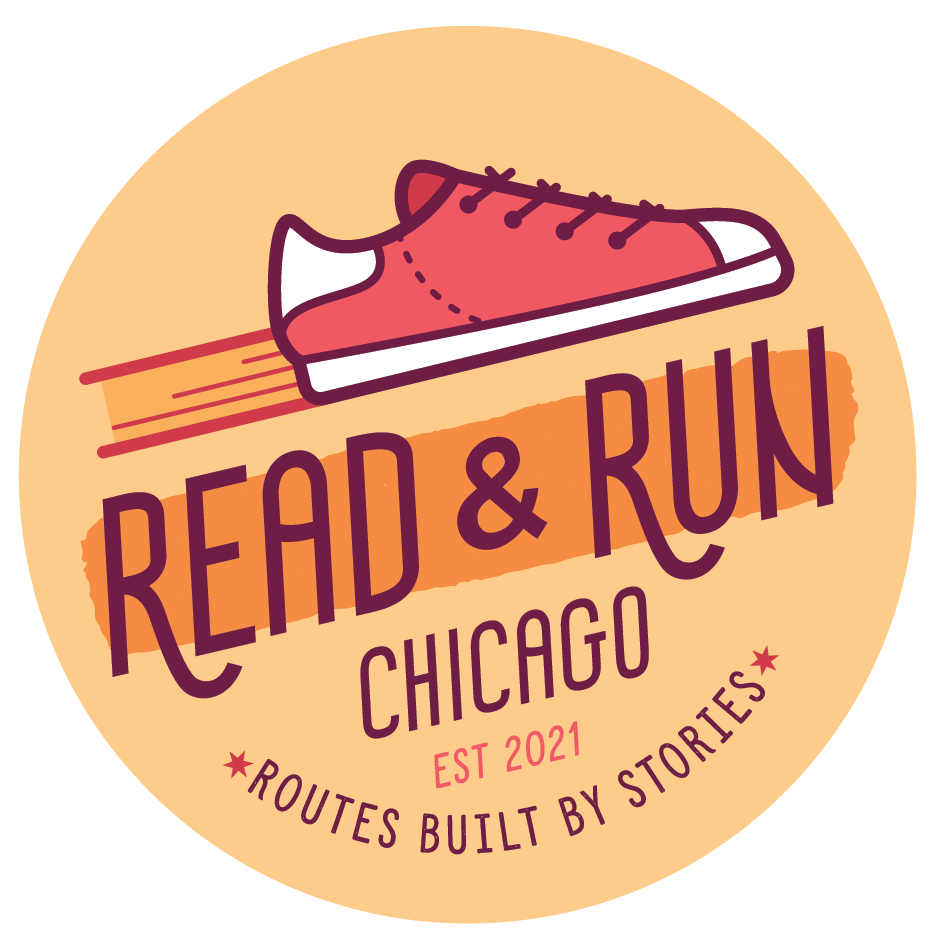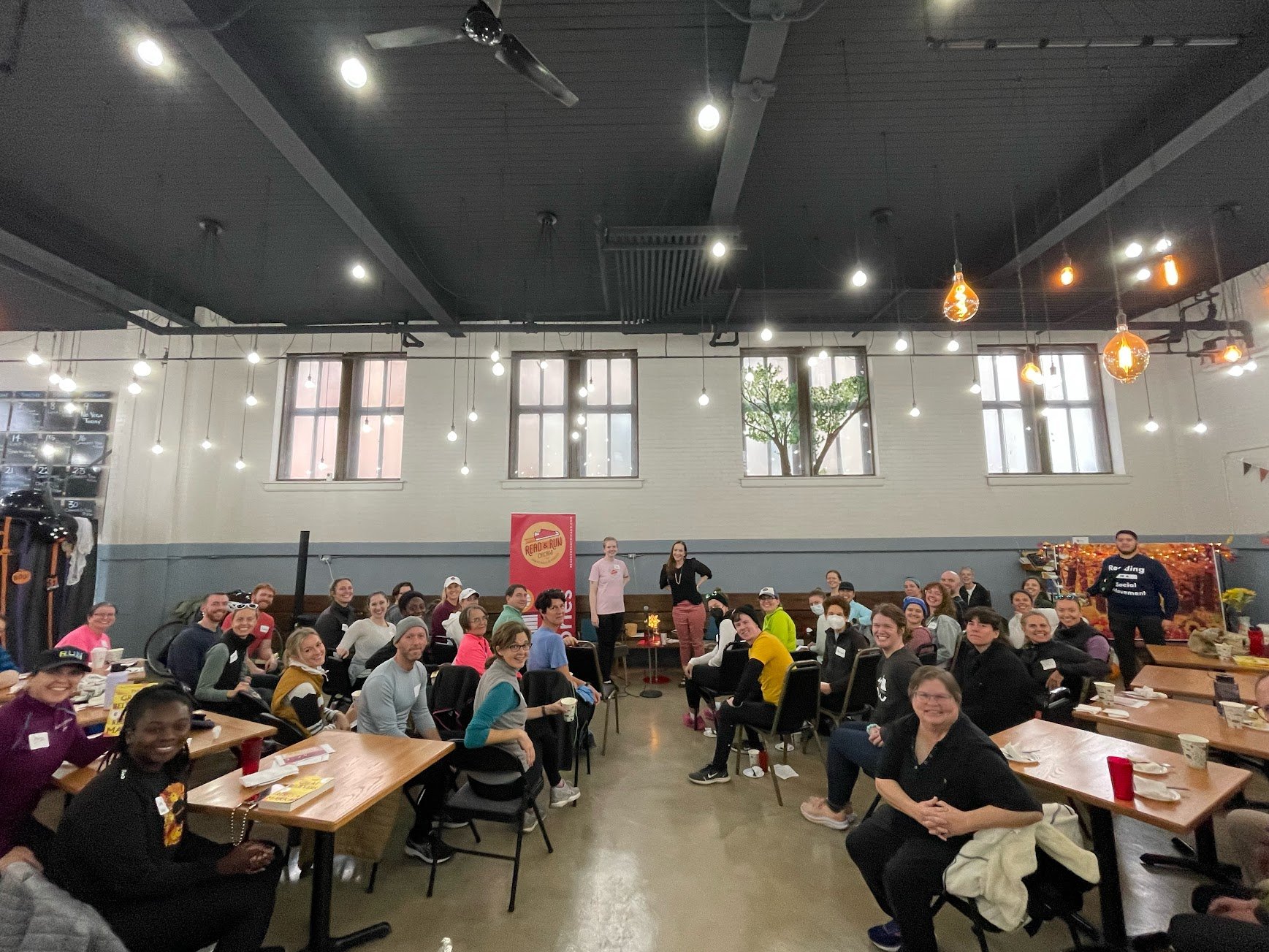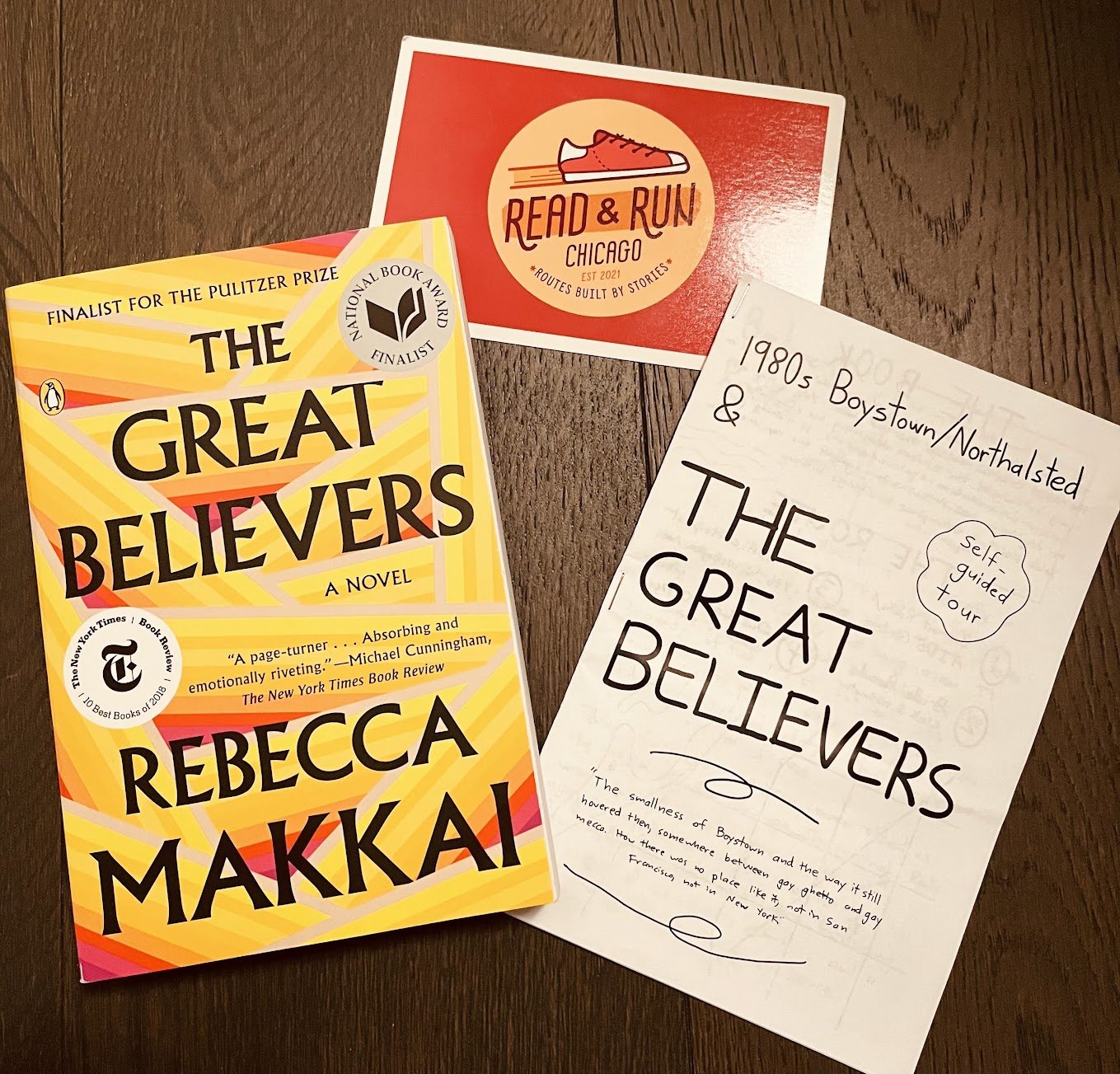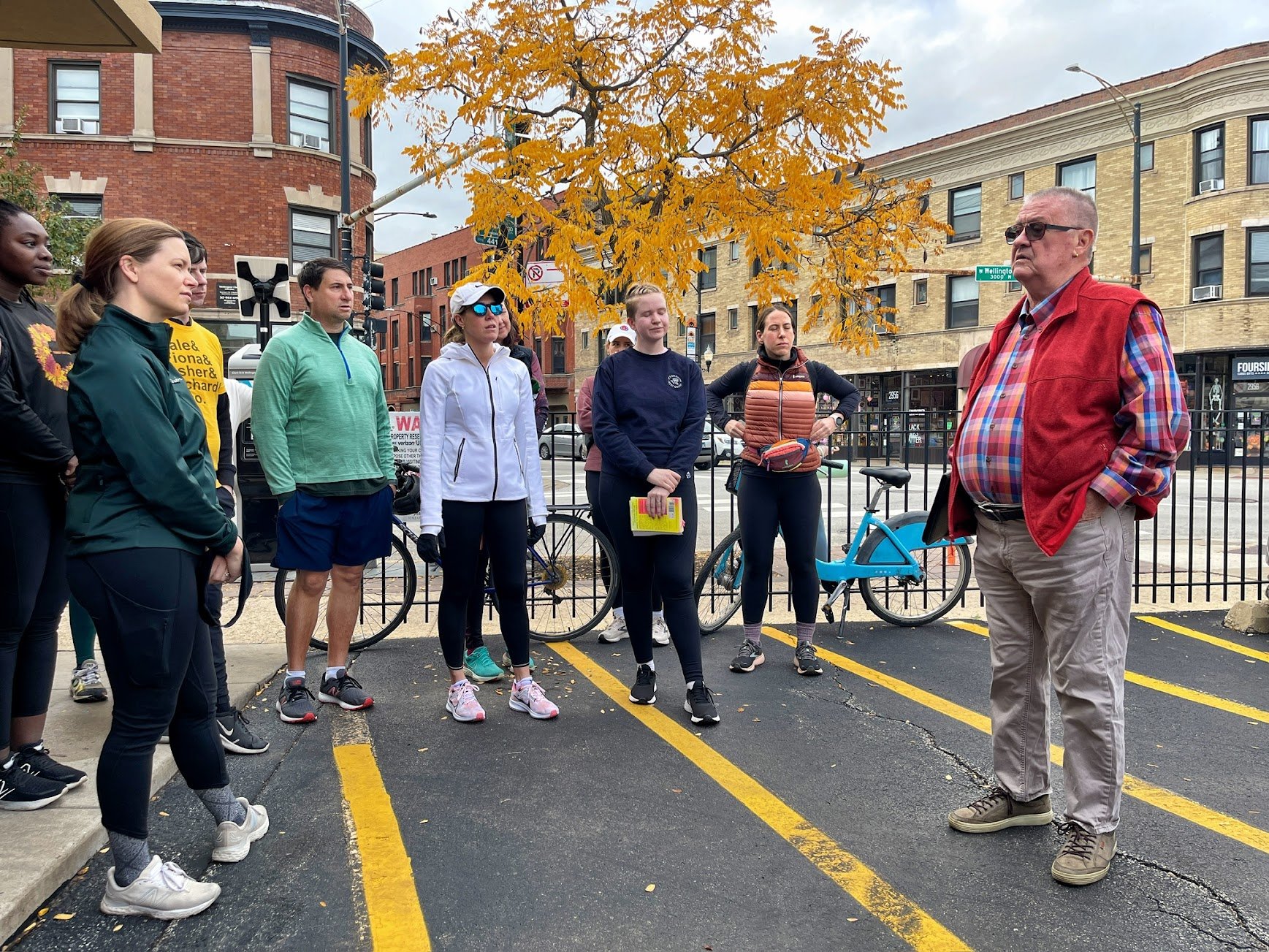The Real-Life Activists That Helped Inspire The Great Believers
By Allison Yates with Quinn Sluzenski
Readers & runners posing with Rebecca Makkai after our Q&A at Third Space in Lakeview in October 2023.
Earlier this summer, The New York Times published the 100 Best Books of the 21st Century, and acknowledged what we’ve (and of course, lots of other people, like the Pulitzer Prize) been saying all along: Rebecca’s Makkai’s 2018 novel The Great Believers is a masterpiece.
Read & Run Chicago hosted Rebecca Makkai in October 2023 following a running tour with guide Quinn Sluzenski through Chicago’s North Side Lakeview neighborhood, where much of the novel takes place. The Great Believers is a novel that centers on the 1980s AIDS epidemic in Chicago. Rather than tell a linear story, the book moves between a 1980s plot line from the perspective of Yale, a gay man, and a 2015 plot line from the perspective of Fiona, who was a young woman in the 80s who knew Yale and all his friends, and is now a middle-aged mother trying to find her estranged daughter in Paris. Both storylines weave together to tell a story of love and loss that stretches across generations, but because we were not in Paris, we focused on Yale’s Chicago story.
Along our three-mile route, we stopped at three different locations central to the characters’ narratives. There, we heard from several activists who would have been contemporaries of Yale, Fiona, and Julian, Asher, or Richard. One of the speakers’ real-life work even inspired the novel’s fictitious newspaper Out Loud, and many of our speakers were (or were friends of) real-life activists who marched in the famous 1990 ACT UP demonstration in the Loop, a pivotal scene in the novel.
Rebecca Makkai did extensive research for this book—books, film, TV, and more—much of which you can reference on her website. What she doesn’t reference (but states in the acknowledgements of her novel and shared during our Q&A), are the stories and resources she received from one of our community partners, Rogers Park-based Gerber/Hart Library and Archives, and Chicago-based activists and LGBTQ elders like Tracy Baim and Owen Keehnen, who we learned from during our live event in 2023.
Meet the Speakers
Pssst! Want to peak the program we had at the event? You can view it here.
Tracy Baim
Tracy Baim speaking to readers & runners in October 2023 about founding Windy City Times, the newspaper that inspired the fictitious Out Loud.
Cofounder Windy City Times, author, activist Tracy Baim
Next to the busy Belmont Red Line station, we heard from Tracy Baim, co-founder of the ongoing newspaper Windy City Times.
In The Great Believers, Yale’s boyfriend, Charlie, owns the gay newspaper Out Loud. The newspaper is the center of a lot of politics and drama in gay Chicago. There is a competing paper that criticizes them for their inadequate lesbian coverage. Out Loud is known for being a loud, prominent advocate for condoms and safe sex. As the book goes on, Out Loud becomes increasingly dysfunctional even as it gets more popular, long term employees leaving for rival papers and infighting at an all-time high. Out Loud is not a real Chicago newspaper, but there has been a LGBTQ+ newspaper scene in Chicago for decades: Windy City Times.
Tracy Baim is the co-founder of Windy City Times and is an author and activist. Her work was used as research in The Great Believers and she was interviewed by Rebecca Makkai for book. She was inducted into the Chicago LGBTQ Hall of Fame in 1994. More information at: www.windycitytimes.com
Gary Chichester
Gary Chichester speaking to readers & runners about The Pride Parade.
Activist Gary Chichester
In the novel, Yale mentions that some of his friends “would be watching [the parade] from a fire escape at Wellington and Clark, with mojitos.” Aptly, we met activist Gary Chichester on the northeast corner of this intersection, which today happens to be the FedEx where guide Quinn Sluzenski photocopied the zine readers & runners received. We love a full circle moment.
In the novel, the parade is an intersection of different worlds: There are drag queens, leather daddies, garden clubs, and awkward local politicians. Harold Washington speaks, as he did at the real 1986 Pride. Yale sees Charlie in the float for the newspaper he owns, Out Loud. The float is themed around condoms and safe sex. And finally, there are Klan protesters with a sign reading “quarantine the queers.” While Pride was born from the Stonewall riots, it quickly became a yearly celebration of queer identity rather than a protest event. While the 1980s Prides were hardly the corporate bonanzas of today’s parade, you can start to see the seeds here of greater acceptance with the mention that there are aldermen and state senators in the parade—“most looking pained.”
Gary has provided over fifty years of commitment and work to the LGBTQ+ communities. In 1971 he co-founded the Chicago Gay Alliance, which created Chicago’s first gay and lesbian community center. He served on the Chicago Commission on Human Relations’ former Advisory Council on Lesbian, Gay, Bisexual and Transgender Issues from 1989 to 2011 and has been a part of Chicago's Pride marches since 1970 (the first march to commemorate the Stonewall rebellion in the world). His signature was on the first permit issued by the City of Chicago for a Pride march in 1971.
Arnie Aprill
Arnie speaking to readers & runners outside Masonic.
Aging Services Community Outreach at Howard Brown Health Arnold Aprill
At Masonic, a setting that looms large over the book, we heard from activist Arnold “Arnie” Aprill, who spoke about the devastating loss of his friend group, becoming an activist, and how Lesbians saved the LGBTQ movement as AIDS ravaged the cis gay male community.
In the novel, several characters live their last days in the AIDS ward there. It’s a kind of home, since many people are in and out of the hospital there, and many more visit lots of friends in their sick beds. The nurses know the patients well and vice versa, and they keep the place decorated and as friendly-feeling as possible. Contrast this with Cook County Hospital, which is where people go when they don't have the insurance for Masonic. Late in the book, Yale attends (and is severely injured in) a protest against inadequate care at County, specifically County’s refusal to admit women. This real protest, one of the largest AIDS demonstrations in the country, resulted in the announcement that County would begin admitting women almost immediately. Howard Brown, a network of Chicago health clinics, is also discussed frequently throughout the book, the beneficiary of a fundraiser at Ann Sather and a hot topic since they recently started offering the HTLV-III test when the book begins. One character, Asher, quit the board in protest, since he believes the test didn’t materially help anyone without proper treatment available and that they would just all end up on a government database. Later in the book Yale considers calling the Howard Brown hotline, but is afraid that someone he knows will answer and recognize his voice—the perils of being in a tight community.
Arnold Aprill is a 71-year-old gay man who is the Community Outreach Coordinator for Aging Services at Howard Brown Health. He is an award-winning writer and theater director with a community organizing background in the areas of school reform and juvenile justice activism. He has been honored with awards from the Ford Foundation, the Chicago Community Trust, and the Fulbright Scholars program for his innovations in integrating arts programming into social justice initiatives. More info here: Geriatric Medicine & Aging Services - Howard Brown Health.
Owen Keehnen
Owen addresses readers & runners at the former site of the Belmont Rocks in Lakeview.
Author/Historian Owen Keehnen
At the modern day AIDS Garden Chicago, we met up with author and historian Owen Keehnen. In the novel, The Belmont Rocks is practically a mythic location. No scenes actually take place there, it exists purely in Yale’s memory and imagination. It feels like the Rocks can’t be tainted by the tragedy of the rest of the book. It’s a haven for gay men, a place where they can find community and security without worrying about homophobia or disease. The Belmont Rocks are associated with Richard Campo, who is older than the rest of the social group and a photographer who recorded the 1980s crowd, notably at the Rocks. Richard is the only gay man who is a prominent character both in the 1980s and 2015 plotlines. He’s a spectator figure who is really the only person in the book who was documenting these people and then presents the history of this period for the wider world.
Queer writer and historian Owen Keehnen has written several fiction and nonfiction books, including his new release on gay Chicago history, Man’s Country: More Than a Bathhouse. For several years, Keehnen has been active in preserving the LGBTQ history of the Belmont Rocks. In addition to speaking on the subject, he has gathered photos and stories on the historic Chicago queerspace (circa 1960-2003). In 2022, the history of the Rocks was formally recognized when the area reopened as AIDS Garden Chicago. Keehnen is cofounder of the LGBTQ education/history organization, the Legacy Project. He was inducted into the Chicago LGBTQ Hall of Fame in 2011. Follow him in on Instagram at @owenkeehnen.












